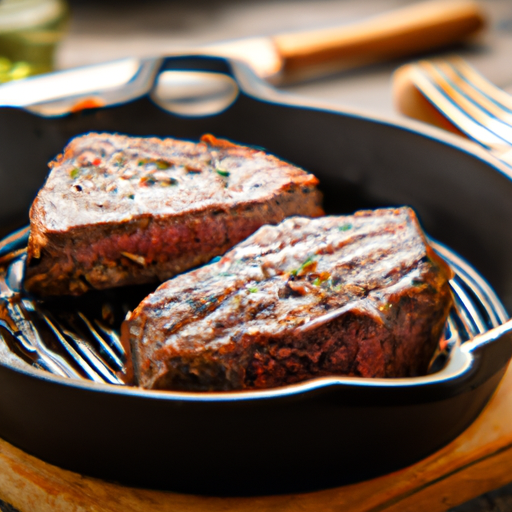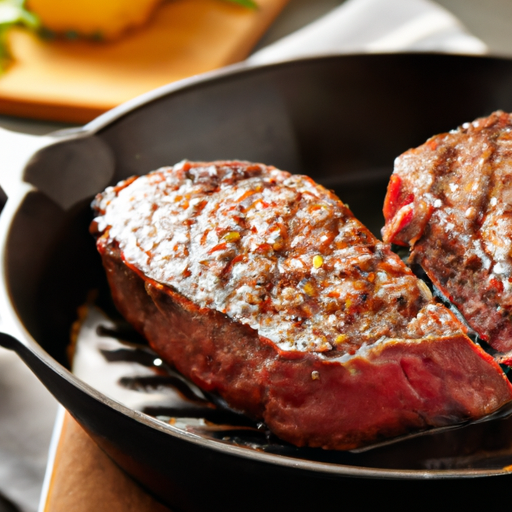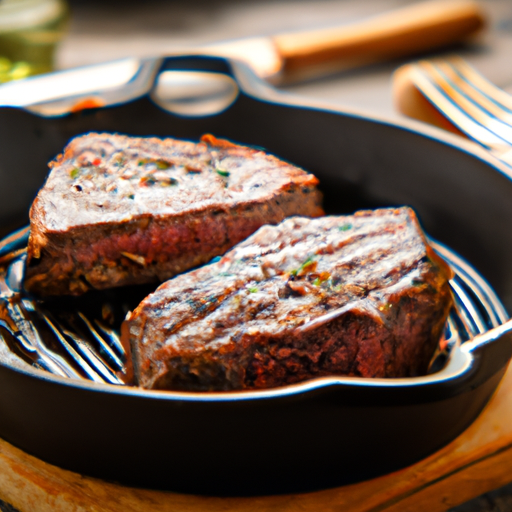Are you tired of not knowing how to cook the perfect steak every time? Look no further! “The Ultimate Guide to Cooking Steak: A Comprehensive Chart for Cast Iron” is here to save the day. This handy guide provides a comprehensive chart that will help you cook steak to perfection using a cast iron skillet. Whether you prefer rare, medium, or well-done, this chart has got you covered. Say goodbye to overcooked or undercooked steaks, and say hello to deliciously cooked meat that will impress your friends and family. Get your hands on “The Ultimate Guide to Cooking Steak: A Comprehensive Chart for Cast Iron” and become a steak-cooking pro in no time.

Selecting the Perfect Steak
Choosing the right steak is the first step towards creating a mouthwatering meal. When it comes to selecting the perfect cut, there are a few factors to consider.
Choosing the Right Cut
Different cuts of steak offer distinct flavors and textures. Some popular cuts include ribeye, filet mignon, New York strip, and sirloin. Ribeye is known for its rich marbling and intense flavor, while filet mignon is prized for its tenderness. New York strip offers a balance of flavor and tenderness, and sirloin is a budget-friendly option with great flavor.
Consider Thickness
The thickness of the steak is also important to ensure even cooking. Thicker cuts, such as 1.5 to 2 inches, are ideal for methods like reverse searing, as they allow for more control over the internal temperature while developing a delicious crust. Thinner cuts, around 1 inch thick, are better suited for high heat searing.
Quality and Freshness
When choosing a steak, always opt for high-quality meat. Look for cuts with bright red color and visible marbling, as this indicates tenderness and flavor. Additionally, make sure the meat is fresh and has been properly stored at a safe temperature.
Marbling and Fat Content
Marbling refers to the thin white lines of fat running through the meat. This intramuscular fat adds flavor and juiciness to the steak. Look for steaks with visible marbling, as this is a good indication of tenderness and flavor. The fat content on the outer edge of the steak, known as the fat cap, also contributes to the overall taste. It is recommended to leave a thin layer of fat on the steak while cooking to enhance the flavor.
Preparing the Steak
Preparing the steak properly can make a huge difference in the final result. It involves a few key steps to ensure that your steak is tender, flavorful, and perfectly seasoned.
Thawing
If your steak is frozen, it’s important to thaw it properly before cooking. The best method for thawing steak is to place it in the refrigerator overnight. This slow thawing method allows the steak to defrost evenly and helps retain its natural juices. Avoid thawing steak at room temperature or using a microwave, as these methods can lead to uneven thawing and may affect the texture of the meat.
Seasoning
Seasoning your steak is essential to enhance its natural flavors. A simple combination of salt and pepper is often all that’s needed, but you can get creative and use other herbs and spices to add depth and complexity. Season the steak generously on both sides, ensuring that every inch is coated for maximum flavor.
Brining
Brining is an optional step that can be done to further enhance the tenderness and juiciness of your steak. A brine is essentially a mix of salt, sugar, and other flavorings dissolved in water. By immersing the steak in this solution for a few hours, the meat can absorb moisture, resulting in a more succulent finished product. However, this step is not necessary for all cuts of steak.
Resting at Room Temperature
Before cooking your steak, it’s crucial to let it rest at room temperature for about 30 minutes. This allows the meat to come to a more even temperature, which ensures more even cooking. Additionally, resting the steak allows the muscle fibers to relax, resulting in a more tender and juicy final product.
Preheating the Cast Iron Pan
Using a cast iron pan is an excellent choice for cooking steak, as it provides even heat distribution, excellent heat retention, and a beautiful sear.
Choosing the Right Pan
When selecting a cast iron pan for steak cooking, opt for one that is large enough to comfortably accommodate the size of your steak. A pan with a diameter of at least 10 inches is recommended to ensure sufficient space for searing.
Cleaning and Seasoning
If your cast iron pan is new, you’ll need to clean and season it before use. To clean the pan, rinse it with warm water and scrub gently with a brush. Avoid using soap, as it can strip the pan’s seasoning. Once clean, dry the pan thoroughly and apply a thin layer of vegetable oil to the cooking surface and the entire pan to prevent rust.
Preheating Method
Proper preheating of the cast iron pan is crucial for achieving a delicious crust on your steak. Place the pan on a stovetop burner over medium-high heat. Allow the pan to heat for at least 5 minutes before adding the steak. You can test if the pan is hot enough by sprinkling a few droplets of water onto the surface. If the water sizzles and evaporates almost immediately, the pan is ready.
Cooking Techniques
There are several cooking techniques you can use to cook your steak to perfection. Each method offers a unique flavor profile and texture, allowing you to tailor your cooking process to your preferences.
High Heat Searing
High heat searing involves quickly cooking the steak over high heat to develop a flavorful crust. Heat the cast iron pan until it reaches smoking point and carefully add the steak. Allow the steak to cook for a few minutes on each side until a deep brown crust forms. This method is perfect for thinner cuts of steak that cook quickly.
Reverse Searing
Reverse searing is a popular technique for thicker cuts of steak and allows for precise control of the internal temperature. Start by cooking the steak in a low oven (around 275°F) until it reaches your desired internal temperature. Finish the steak by searing it in a hot cast iron pan for a few minutes on each side to develop a caramelized crust.
Pan Roasting
Pan roasting is a versatile method that combines both stovetop and oven cooking. Start by searing the steak in a hot cast iron pan for a couple of minutes on each side. Then, transfer the pan to a preheated oven and continue cooking until the desired internal temperature is reached. This method is great for achieving an evenly cooked steak with a rich crust.
Butter Basting
Butter basting is a technique that adds extra flavor and moisture to your steak. After searing the steak in a hot cast iron pan, add a couple of tablespoons of butter and some herbs to the pan. Tilt the pan slightly and spoon the melted butter over the steak continuously for a minute or two. The butter will infuse the steak with flavor while keeping it moist.

Determining Doneness
Achieving the perfect level of doneness is crucial to ensure that your steak is cooked to your liking. There are several methods you can use to determine the doneness of your steak.
Using a Meat Thermometer
Using a meat thermometer is the most accurate way to determine the internal temperature of your steak and ensure it’s cooked to your desired level of doneness. The following are the recommended internal temperatures for different levels of doneness:
- Rare: 120-125°F
- Medium Rare: 130-135°F
- Medium: 140-145°F
- Medium Well: 150-155°F
- Well Done: 160°F and above
Insert the meat thermometer into the thickest part of the steak, avoiding any bones or fat, and check the temperature when close to the desired level of doneness.
Visual Indications
Experienced chefs often rely on visual cues to determine the doneness of a steak. As the steak cooks, its color and texture change. A rare steak will have a deep red interior and a cool, red center. A medium-rare steak will have a warm, pink center with a hint of red. A medium steak will have a pink center and slightly cooked outer edges. A medium-well steak will have a warm, slightly pink center with a mostly cooked interior. A well-done steak will have a uniformly cooked brown interior with no traces of pink.
Finger Test
The finger test is a handy trick that can be used to estimate the doneness of your steak. Gently press the center of the steak with your finger. If the steak feels soft and springy, it is likely rare. A slightly firmer steak indicates medium-rare. A firm steak with a little give is medium, while a steak that is firm with no give is well done.
Cooking Temperatures and Times
The cooking time and temperature will vary depending on the thickness of the steak and the desired level of doneness. The following are general guidelines to help you achieve your desired results:
Rare
For a 1-inch thick steak, cook at high heat for approximately 2-3 minutes per side for rare. Adjust the cooking time based on the thickness of the steak.
Medium Rare
For a 1-inch thick steak, cook at high heat for approximately 3-4 minutes per side for medium rare. Adjust the cooking time based on the thickness of the steak.
Medium
For a 1-inch thick steak, cook at high heat for approximately 4-5 minutes per side for medium. Adjust the cooking time based on the thickness of the steak.
Medium Well
For a 1-inch thick steak, cook at high heat for approximately 5-6 minutes per side for medium well. Adjust the cooking time based on the thickness of the steak.
Well Done
For a 1-inch thick steak, cook at high heat for approximately 6 minutes per side for well done. Adjust the cooking time based on the thickness of the steak.
Resting and Slicing
Resting the steak after cooking is essential to ensure that the juices redistribute and the meat remains tender. Slicing the steak properly is equally important to preserve its natural flavors and textures.
Resting Period
After removing the steak from the pan, transfer it to a cutting board and let it rest for about 5-10 minutes. This resting period allows the juices to settle and redistribute throughout the meat, resulting in a juicier and more tender steak. Tent the steak loosely with foil to help retain its heat.
Proper Slicing Techniques
When slicing the steak, use a sharp knife and cut against the grain. Cutting against the grain helps to shorten the length of the muscle fibers, resulting in a more tender bite. For maximum tenderness, slice the steak into thin slices, about ¼ to ½ inch thick.
Accompaniments and Serving Suggestions
To complement your perfectly cooked steak, consider adding a few delicious accompaniments and serving suggestions.
Sauces and Butters
Enhance the flavor of your steak with a variety of sauces and compound butters. Classic steak sauces like béarnaise, chimichurri, or peppercorn can elevate the taste of your meat. Alternatively, experiment with flavored butters by mixing in ingredients like garlic, herbs, or blue cheese to create a creamy and flavorful topping.
Side Dishes
Pair your steak with a variety of side dishes to round out the meal. Classic choices include roasted vegetables, garlic mashed potatoes, or a fresh garden salad. Alternatively, opt for more unique options like grilled asparagus, creamy polenta, or loaded baked potatoes.
Wine Pairing
Choosing the perfect wine to accompany your steak can take your meal to the next level. For red meat, opt for full-bodied red wines like Cabernet Sauvignon, Malbec, or Syrah. These wines complement the richness and flavor of the steak, creating a harmonious pairing. If you prefer white wine, a full-bodied Chardonnay can also be enjoyed with certain cuts of steak.
Tips and Troubleshooting
While cooking steak is relatively simple, there are a few tips and troubleshooting techniques to remember to ensure the best possible results.
Maintaining Proper Heat
To ensure a perfect sear, it’s important to maintain proper heat throughout the cooking process. Avoid overcrowding the pan, as this can lower the temperature and prevent the steak from caramelizing properly. Additionally, adjust the heat as necessary to prevent the pan from getting too hot and causing the steak to burn.
Avoiding Overcooking
Timing is key when it comes to cooking steak. Keep a close eye on the cooking time and check the internal temperature frequently to avoid overcooking. Remember that the steak will continue to cook slightly while resting, so it’s better to remove it from the heat just before it reaches the desired doneness.
Dealing with Smoke
Cooking steak in a cast iron pan can sometimes create smoke, especially when using high heat. To minimize smoke, ensure proper ventilation in your kitchen by opening windows or using the exhaust fan. You can also add a small amount of oil or butter to the pan instead of directly coating the steak, as this can help reduce smoke.
Adding Flavor with Herbs and Spices
Experimenting with different herbs and spices can add depth and complexity to your steak. Consider using ingredients like rosemary, thyme, garlic, or smoked paprika to infuse the meat with additional flavors. Sprinkle these seasonings onto the steak before cooking or add them to the pan while basting with butter for an extra kick.
Cleaning and Maintenance
Properly cleaning and maintaining your cast iron pan is essential to ensure its longevity and optimal performance.
Cleaning the Cast Iron Pan
After cooking your steak, allow the pan to cool slightly before cleaning. Use a soft brush or sponge to gently scrub the pan with warm water. Avoid using soap, as this can remove the pan’s seasoning. Dry the pan thoroughly with a clean towel or by placing it over low heat on the stovetop.
Seasoning and Storing
To maintain the seasoning of your cast iron pan, it’s important to apply a thin layer of oil after each use. This helps to prevent rust and keeps the surface non-stick. Rub a small amount of vegetable oil or flaxseed oil onto the cooking surface and the entire pan. Store the pan in a cool, dry place to prevent moisture buildup.
By following these comprehensive steps and techniques, you can confidently cook a delicious steak every time. Whether you prefer a perfectly seared ribeye or a tender filet mignon, the key is to choose the right cut, prepare it properly, and cook it with care. So, grab your cast iron pan and get ready to create a culinary masterpiece that will impress your family and friends. Happy cooking!
